
Hieracium , known by the common name hawkweed and classically as hierakion, is a genus of flowering plant in the family Asteraceae, and closely related to dandelion (Taraxacum), chicory (Cichorium), prickly lettuce (Lactuca) and sow thistle (Sonchus), which are part of the tribe Cichorieae. Hawkweeds, with their 10,000+ recorded species and subspecies, do their part to make Asteraceae the second largest family of flowering plants. Some botanists group all these species or subspecies into approximately 800 accepted species, while others prefer to accept several thousand species. Since most hawkweeds reproduce exclusively asexually by means of seeds that are genetically identical to their mother plant, clones or populations that consist of genetically identical plants are formed and some botanists prefer to accept these clones as good species whereas others try to group them into a few hundred more broadly defined species. What is here treated as the single genus Hieracium is now treated by most European experts as two different genera, Hieracium and Pilosella, with species such as Hieracium pilosella, Hieracium floribundum and Hieracium aurantiacum referred to the latter genus. Many members of the genus Pilosella reproduce both by stolons and by seeds, whereas true Hieracium species reproduce only by seeds. In Pilosella, many individual plants are capable of forming both normal sexual and asexual (apomictic) seeds, whereas individual plants of Hieracium only produce one kind of seeds. Another difference is that all species of Pilosella have leaves with smooth (entire) margins whereas most species of Hieracium have distinctly dentate to deeply cut or divided leaves.
A dry roadside dotted with small, ¾ inch red orange flowers, interspersed with very similar yellow ones, and often the white of daisies, is a good sign that you are in Hawkweed country.

Silphium is a genus of North American plants in the tribe Heliantheae within the family Asteraceae.

Coreopsis is a genus of flowering plants in the family Asteraceae. Common names include calliopsis and tickseed, a name shared with various other plants.
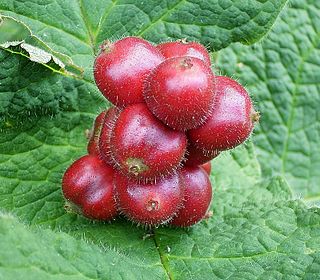
Triosteum, commonly known in American English as horse-gentian or, less commonly, feverwort, and, in Standard Chinese as 莛子藨属, is a genus of flowering plants belonging to the family Caprifoliaceae. A genus of six species in total, it has three species native to North America, and three more in eastern Asia.

Baptisia is a genus in the legume family, Fabaceae. They are flowering herbaceous perennial plants with pea-like flowers, followed by pods, which are sometimes inflated. They are native to woodland and grassland in eastern and southern North America. The species most commonly found in cultivation is B. australis.

Symphyotrichum is a genus of over 100 species and naturally occurring hybrids of herbaceous annual and perennial plants in the composite family Asteraceae, most which were formerly treated within the genus Aster. The majority are endemic to North America, but several also occur in the West Indies, Central and South America, as well as in eastern Eurasia. Several species have been introduced to Europe as garden specimens, most notably New England aster and New York aster.

Rhododendron minus var. chapmanii, also known as Chapman's rhododendron, is an endangered variety, endemic to Florida, of the evergreen Piedmont rhododendron.

Orthocarpus, or owl's-clover, is a genus of flowering plants in the family Orobanchaceae (broomrapes). They are native to North America. A number of species formerly included in Orthocarpus have been transferred to the genus Castilleja, which includes the plants commonly known as Indian paintbrush. Plants of the genus are generally less than 30 centimetres (1 ft) in height.

Symphyotrichum eatonii is a species of aster known by the common name Eaton's aster. It is native to much of western North America from British Columbia to Saskatchewan, the Sierra Nevada in California, the Rocky Mountains region, to Arizona and New Mexico, where it grows in many habitats, especially wet areas such as meadows and near ditches.

Quercus chapmanii, commonly referred to as the Chapman oak, is a species of oak that grows in the southeastern United States.

Solidago odora, the sweet goldenrod, anisescented goldenrod or fragrant goldenrod, is a North American species of goldenrod within the family Asteraceae. The plant is native to the United States and Mexico, found in every coastal state from Veracruz to New Hampshire and as far inland as Ohio, Missouri, and Oklahoma. It flowers from July through October.
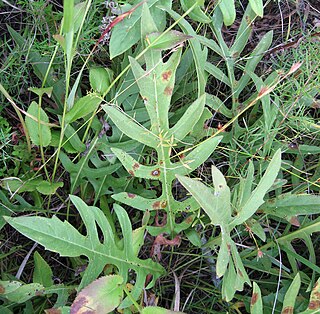
Silphium pinnatifidum, the tansy rosinweed or cutleaf prairie dock, is a species of flowering plant in the family Asteraceae. It is native to the Southeastern United States where it is found in Alabama, Georgia, Kentucky, and Tennessee. Its habitat is prairies, barrens, and cedar glades.
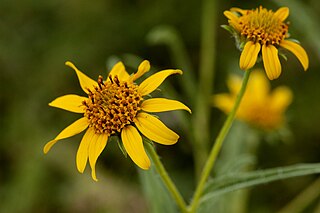
Heliomeris hispida is a North American species of flowering plants in the family Asteraceae called the hairy goldeneye or rough false goldeneye. It is native to the southwestern United States and also to the northern Sierra Madre Occidental of western Chihuahua and eastern Sonora in Mexico. There are a few reports of the species growing in California, but these are most likely introduced populations.
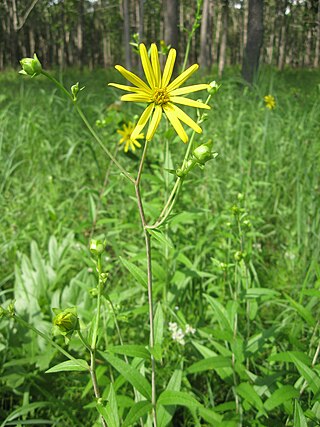
Silphium trifoliatum, commonly known as whorled rosinweed, is a species of flowering plant in the family Asteraceae. It is native to the eastern United States, where it is found east of the Mississippi River. Its natural habitat is open, grassy areas such as prairies, river cobble bars, and roadsides. It is a tall perennial that produces heads of yellow flowers in mid-summer through fall.
Polygala chapmanii is a flowering plant species in the milkwort family (Polygalaceae). It is endemic to states in the southeastern United States bordering the Gulf of Mexico including Alabama and parts of the Florida panhandle but is not reported from Texas. It is an annual and grows to about two feet tall. It is a dicot.

Thaspium trifoliatum, commonly called meadow-parsnip or purple meadow-parsnip is a species of flowering plant in the carrot family (Apiaceae). It is native to eastern North America where it is found in many eastern U.S states and in Ontario, Canada. It has a broad natural habitat, which includes mesic to dry forests and woodlands, prairies, bluffs, and rock outcrops.

Symphyotrichum chapmanii is a species of flowering plant in the family Asteraceae native to the Apalachicola River drainage basin of Alabama and Florida. Commonly known as savanna aster, it is a perennial, herbaceous plant that may reach 30 to 80 centimeters tall. Its flowers have purple to blue-lavender ray florets and pale yellow disk florets. It is a wetland species and is of conservation concern. It may be extirpated in Alabama.
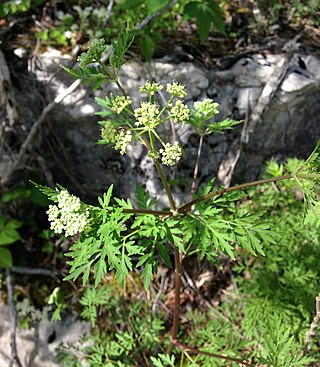
Thaspium pinnatifidum, commonly called cutleaf meadow-parsnip, is a species of flowering plant in the carrot family (Apiaceae). It is native to eastern North America where it is found in the southern Appalachian Mountains, being found in parts of Georgia, Kentucky, North Carolina, and Tennessee. Within these states it has a sporadic and limited range
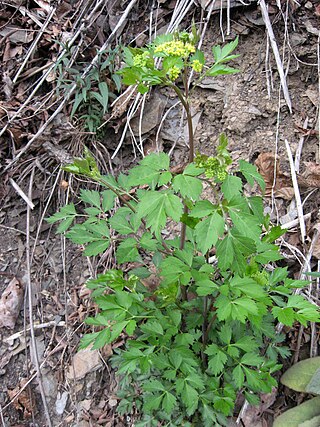
Thaspium barbinode, known by the common names of bearded meadow-parsnip and hairy-jointed meadow-parsnip, is a member of the carrot family, Apiaceae. It is a perennial herb, native to the eastern United States, from eastern Texas to southeastern Wisconsin and the Florida panhandle to southern New York. Compared to Thaspium chapmanii, the herb is shorter, and has similar bright yellow flowers.


















